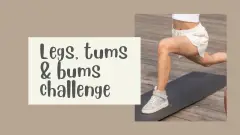About this standing butt workout challenge
Intensity level: beginner/intermediate
Benefits: strengthens and tones the glute (butt) muscles
Safety: please read the general safety information here. Also, if you’re working on a hard floor, make sure your footwear won’t slip. Barefoot or trainers is best.
Warm up: you should warm up your muscles and joints by doing the warm up exercises shown in the exercise instructions section below.
What you need: all you need for this workout is a chair and some wall space.
Standing butt workout challenge chart
The chart shows the reps for each exercise every day and instructions for the exercises are below the chart. For the exercises that are done one leg at a time (everything other than the 2 squat exercises), do the number of reps shown on the chart on each leg. So on day 1 for example, do 12 side leg raises on the first leg, then swap round and do 12 on the other leg. Then do the same for the leg lifts behind.

Exercise instructions
Warm up
Before you do your challenge exercises every day, warm up your glutes by doing 16 alternating lunges behind:

Challenge exercises






The role of the glutes in standing
Although we’re not aware of it, various muscles work together to hold us in our upright standing position. Among these, the glutes, or gluteal muscles, play a key role in maintaining balance, stability, and proper posture.
Key Functions of the Glutes in Standing
-
Hip Extension: The gluteus maximus, the largest of the three gluteal muscles, is the main extender of the hips, pulling the torso upright from a squatting position. This action is essential for initiating movement and maintaining an upright posture.
-
Pelvic Stabilization: The gluteus medius and gluteus minimus work together to stabilize the pelvis, preventing it from tilting forward or backward. This stability is important for maintaining balance and proper alignment of the spine.
-
Weight Distribution: The glutes distribute weight evenly across the hips and legs, preventing excessive strain on any one joint. This even distribution helps to prevent pain and discomfort, especially during prolonged standing.

